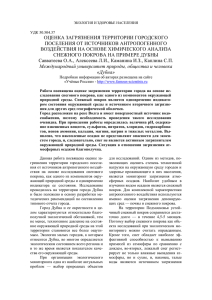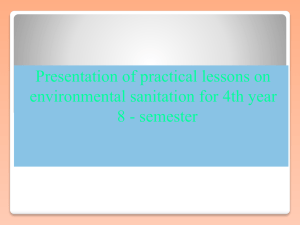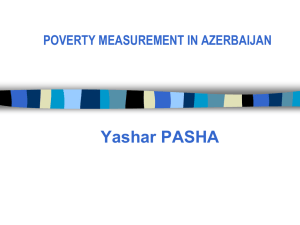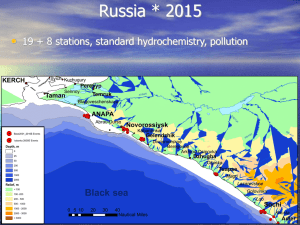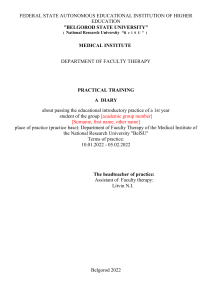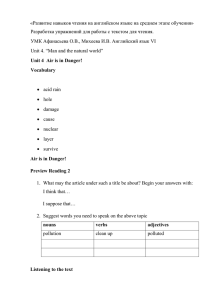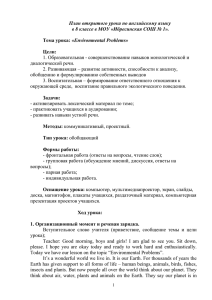gas analyzer
реклама
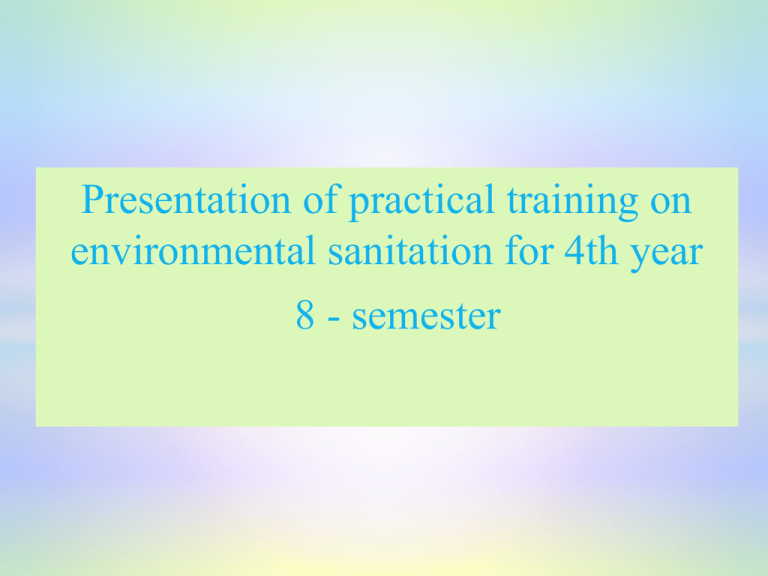
Presentation of practical training on environmental sanitation for 4th year 8 - semester Hygienic evaluation of the organization of sanitary protection zones (SPZ) (SanPiN 0006-96) Hygienic assessment of air quality according to a stationary point of control. Method of "Rose gassed" and "dusty rose". Method of collecting materials for hygienic assessment of air quality. Evaluation of laboratory studies on the basis of selected samples of air (determination of NO2, SO2) 1 2 3 4 5 • Hygienic assessment of the organization SPZ • Hygienic assessment of air quality according to a stationary point of control. • Method of "Rose gassed" and "dusty rose". •. • Method of collecting materials for hygienic assessment of air quality • Evaluation of laboratory studies on the basis of selected samples of air (determination of NO2, SO2) The purpose of employment: - To familiari ze students with the basic hygienic require ments for the organiza tion of the SPZ To introduc e students to design material s on the organiza tion of the SPZ Familiari ze students with the require ments imposed on the territory of the SPZ Consider a system of measure s for sanitary protecti on of atmosph eric air Learn how to make a written report with suggesti ons to improve the health of air Acquaint ed with the methods of carrying out laborator y tests of air Learn to asses s the sanit ary condi tion of atmo spher ic air The student should know -Know the sources of air pollution, their comparative hygienic assessment to know the role and importance undertorch route studies and fixed positions to assess the state of air and development activities in San. Air Protection. Technique know the correct size of the SPZ Be able to make an opinion on the health organization SPZ - How to assess the extent of air pollution Know the aspiration method of sampling, air sampling vessels, determine the end-wee sulfur dioxide 1 to exercise the current sanitary inspection on under control municipal objects 2 to carry out visual, laboratory and tool, calculation methods of definition for a hygienic assessment of factors of environment 3.the account to conduct sanitary and hygienic examinations of objects of supervision and to make the corresponding registration and reporting documentation; The student has to be able 4. to conduct laboratory researches on the corresponding subject 5To exercise the current sanitary inspection on under control municipal objects 7 to carry out visual, laboratory and tool, calculation methods of definition for a hygienic assessment of factors of environment; 6 to carry out visual, laboratory and tool, calculation methods of definition for a hygienic assessment of factors of environment. SPZ to the border of residential development should be established. For companies with technological processes, which are sources of air pollution harmful and unpleasant smelling substances directly from the sources of air pollution emissions focused (through pipes, mines) or diffuse emissions (through the lights of buildings), as well as from the unloading of raw materials or open storage. For companies with technological processes, which are sources of noise, vibration, electromagnetic waves, radio and other harmful factors entering into the environment of buildings, structures and sites where installed production equipment create these hazards. Atmospheric pollution from the hygienic point of view are characterized by two main indicators: quality caused by chemical and physico-chemical nature of the contamination; quantifies the strength or intensity destyviya this pollutant. The impact of emissions on the environment, the following SPZ in accordance with the hazard class companies: 1 CLASS– 1000 m 2 CLASS– 500 m 3 CLASS– 300 m 4 CLASS– 100 m 5 CLASS– 50 m The enterprise alleged industrial construction, where the average value of the repeatability of the wind at rumbovoy reference system exceeds 12.5%, ie differs from the circular "wind rose" must adjust the size and configuration of the SPZ for consistency with HF in 363-74. This correction is performed according to the formula: Lo x P L = -----------; Rho Where L - SPZ boundaries defined by the value of (m) Lo - the value zone in accordance with the sanitary classification of production CH 245-71 (m) Po - average frequency of winds in the circular "wind rose"; P - repeatability of wind in a particular naprvlenii (in%) according to the average "wind rose" SPZ for thermal power plants and boiler on the calculation determines the dispersion in the atmosphere contained in the emissions of harmful substances in accordance with the "Guidelines on the calculation of atmospheric dispersion of emissions enterprises CH 369-74. These guidelines are based on data on the spread of contamination in the air, depending on the height of the ejection, the temperature of physico-chemical properties and meteorological conditions. If you see more than MPC - air pollution occurs; See if . released into the atmosphere substances equal to or less MPC, it is allowed in residential areas and can not be considered as pollution. For hot emissions from a single source with a round mouth of the maximum surface concentration (L) is given by: AxMxFxmxn Cm = ------------------------H N M1x where A - factor determining the conditions of horizontal and vertical dispersion of pollutants; M - amount of substance emitted to the atmosphere; F - dimensionless coefficient that takes into account the rate of sedimentation of harmful substances into the atmosphere; H - height of the emission source V1- discharged volume of the mixture; T - the temperature difference, the exhaust gases and the air in 13 hours for the hottest month of the year; The value of m is determined according to the schedule, depending on the value of f / f = 103 W0h D ------------- Where H2 x T D - diameter of the mouth istoyanika release in meters W0 - exit velocity of the gas mixture in the mouth of m / s. The coefficient is determined by the special plan, depending on the value of V m. V1h T (V m = 0.65 x ------------), which in turn determines the schedule H depending on the height of the pipe (H) and the product of V1 x T. To simplify the calculation of the maximum surface concentration (see) you can use the formula: Cm = M x A x F x m x n x Q where 1 Q = ---------------H2 x V1 x T The quantity Q is determined by the nomogram depending on the height of the pipe (H) and the product V1 × T (m3 / deg / s). Class 1 (SPZ - 1000 m) * 1. Production of nitrogen * production of cellophane * the production of acid * production of alcohol * Production of chemical drugs Chemical plants Class 2 (SPZ 500 m) Production of soda ash production of alcohol Production of esters Venture for the production of asbestos products Production of acetic acid Polyethylene production of nicotine Class 3 (300 m) 1 Mineral salts 2. Production of plasticizers 3. Production of varnishes 4. Production of varnishes 5. Production of polyester 6. Production of methionine Production of antibiotics by biological Class 4 (100 m) papermaking production of glycerol Manufacture of soap Production of sugar vanilla production of perfumes Production of artificial skin Production of synthetic detergents Class 5 (50) Production of artificial pearls Manufacture of printing inks Manufacture of finished medicines Production of various kinds of paper production of carbon dioxide Photochemical production of paper 7. Paragraphs tank cleaning According to state standard specification of 17.2.3.01-86 supervision over pollution of atmospheric air are made on stationary, route and mobile (subtorch) posts. Stationary posts are intended for ensuring continuous registration of the content of the polluting substances or regular sampling of air for the subsequent analysis. Stationary posts represents the special pavilions equipped with the necessary equipment. Route posts are intended for regular sampling of air in the fixed district point at the observations made on the mobile equipment. The number of fixed positions and route determined by population, area and topography, industrial development, and deployment of recreation and resort areas The maximum number of stations is determined by the regulations 1 post - up to 50 000 inhabitants 2-3 posts 100,200,000 inhabitants 3-5 posts 200,500,000 inhabitants 5-10 positions more than 500 000 inhabitants 10-20 posts more than 1 million. ResidentsZ Observations on the block positions is carried out with a special machine on which you install the necessary equipment and devices. Sampling block positions arranged based on a motor vehicle can be made sampling 8-10. One car can drive around 4-5 posts sampling at each post must be carried out 2 times a day. The order of the detour route posts monthly change to sampling on each of them was carried out at different times of day. Organization monitoring the state of the atmosphere in the settlements, stationary and block positions assigned to the State Committee on Hydrometeorology. The doctor hygienist uses these results in these positions to assess the extent of air pollution in the village and the study of public health in relation to environmental pollution. Sampling is desirable to produce a selected distance not less than three points simultaneously. To this end, a motor vehicle equipped with offset points with independent power supplies, which are located on both sides of the plume at distances equal to 1/25 of a circle of radius R. In addition some post set in upwind emission source at a distance, excluding the impact of the subject source of the value of the concentration of the pollutant. In the process of air sampling are monitoring the state of the plume Observation lead the typical ingredients of the enterprise, taking into account the quantity and characteristics of toxic emissions. In the area of maximum possible contamination should be selected at least 50-60 air samples for each ingredient in different seasons. In other areas, at least 25 samples are taken. The results of research and observation is made in the "Protocol for Air Research populated areas" (accounting form 329 / y) When conducting undertorch supervision in the city with a lot of industrial enterprises need to select a few basic (3-5), the most powerful sources of air pollution and sampling produce alternately depending on the wind direction and the torch of these sources. Data processing method of stationary points To construct rose dust and gas content primarily computes the average concentrations of dust and sulfur dioxide, or the needs of other industrial pollution for each month of the year. To this end, on a separate sheet of paper write out the concentration of sulfur dioxide and dust for morning and evening samples within one month to 16 below listed rumba and during the calm. C - 9-10 CER - 103 10-10 SV - 11-103 UTC -12 -3103 B - 13 - 3 V10V-14 3C3 10B -15 - C 3 1010V -16 -SS3 The arithmetic average calculated by the formula WHERE: X is a front arithmetic value of dust and sulfur dioxide for each determination х= Е х y/n E is the sign of summation N- is the number of terms of the series Scale approximately: Dust 0.1 mg / m 2 cm Gas 0.1 mg \ ml of 1 cm Interactive teaching methods. Divide the group into small groups of 2-3. All students offer one job as specific issues related to the topic. List the questions to be answered by each MG, specify the value in points. Each MG discusses and writes to mark their answers. To this value is 10 minutes. The teacher then takes each MG and conduct analysis aloud the correct answers to each question. For each correct answer inserted corresponding points are then calculated the amount of points scored by each MG. T.E.Otsenka knowledge students each MG. • The method of sampling the air: 1 2 3 • vacuum method • Method of filling containers • aspiration method Instruments used for air sampling: • Absorption glass vessels 1 • Gas pipette, gas analyzer, electric aspirator 2 • AFA filters. 3 Rules of air sampling Atmospheric air is taken for analysis either by aspiration clock or intermittent way at least 10 samples within a day with proper intervals and then calculating the arithmetic mean, which is the first method determines the average concentration. Determination of average concentration is the aim of the study. Therefore, the sampling is carried out systematically, over a long period of time up to a year. Zonal distribution around the source of air pollution produced by different rumba, at different distances, in different seasons, at each point on the 3 samples of which takes into account only the maximum. Systematic monitoring of air cleanliness in the village is held in several places; the duration of observation may be limited to 10 consecutive days in each season of the yea The maximum single concentration is determined by short-term (15-20) selecting at least 25 samples in the flame of the main source of pollution, ie downwind, at the time the largest air pollution. Atmospheric air is not considered responsible hygienic standards, if the average daily samples of 10 or 25 one-time maximum of two or more samples found concentrations exceeding limits. *New educational technology used in the lesson What equipment is used for air intake AFA filters gas pipette . gas analyzer electric aspirator test questions -1. The composition of GOST 17. 2. 3. 01 - 86 -2. Types of surveillance -3. Fixed monitoring stations -4. Routing observation posts -5. Undertorch observation posts -6. Selecting a location for the post -7 What determines the size of the SPZ -8 Requirements planting area SPZ. -9 Requirements landscaping SPZ -10 Methods of air sampling. -11 Device "mole" when applied * References: Summary: 1. "Health" under the guidance of prof. Demidenko NM T. 2003 2. Guide to laboratory work on communal hygiene Goncharuk EI Moscow 1990 3. Sh.T.Otaboev, T.I.Iskandarov, G.T.Iskandarova "Kommunal hygiene" Tashkent 2010 th. 4 "Kommunal gigienadan Amal mashgulotlar Uchun ukuv kullanma. "Edited by Academician Iskandarova TI T. 2006y 5. "Communal Hygiene" E.I.Goncharuk Kiev in 2007 I, II part *Internet sites O'z.Res.SSV veb-sayt WWW.minzdrav.uz TTA sayti – WWW.tma.uz. htt://web.tma TMA Wi-Fizone ZiyONet
